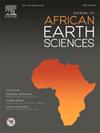埃及尼罗河三角洲东部近海上新世-下更新世高分辨率有孔虫生物地层学
IF 2.2
4区 地球科学
Q2 GEOSCIENCES, MULTIDISCIPLINARY
引用次数: 0
摘要
本研究对Andaleeb-1、Temsah-NW-10和Barboni-NW-1井中三个上新世-下更新世地层进行了高分辨率有孔虫生物地层分析,这些井是为尼罗河三角洲东部海上天然气勘探而钻探的。研究的层序从下到上分为两个岩石单元:Kafr El-Sheikh组和El-Wastani组。所研究的演替序列在大部分地区浮游有孔虫记录较少,而底栖有孔虫记录更为丰富和多样,特别是在调查剖面的顶部。对记录的有孔虫组合进行了生物地层分析,发现有6个浮游有孔虫带和3个底栖有孔虫带,其标志种与地中海盆地标准一致。浮游带由高到低依次为NPP-1(尼罗河三角洲上新世浮游)带、NPP-2带、NPP-3带、NPP-4带、NPSP-1(尼罗河三角洲更新世浮游)带和NPSP-2带。三个底栖带依次为尼罗河三角洲上新世底栖带NPB-1、尼罗河三角洲更新世底栖带NPB-2和尼罗河三角洲更新世底栖带NPSB-1。然而,一些生物事件用于确定地带性边界的可靠性受到研究区域某些标记物种的稀缺性和斑块性分布的挑战。作为NPP-1带的关键标志,由于在另外两口井中没有发现上新世底部,因此只能在一口井中初步识别出球形沉积顶点。作为地中海标准MPL-5区细分的标志种Globorotalia bononiensis的有限出现,使NPSP-1区与地中海标准分区的相关性变得复杂。由于生物分带作用,下上新世(赞新世)与下更新世(格拉西世)之间由于皮亚琴期的完全或部分缺失,形成了不整合面。Gelasian阶段(下更新世)的开始标志着尼罗河三角洲的退化,这导致了营养丰富的浅海环境的发展,支持了相对多样化和丰富的底栖有孔虫组合。本文章由计算机程序翻译,如有差异,请以英文原文为准。
Pliocene-Lower Pleistocene high-resolution foraminiferal biostratigraphy of offshore eastern Nile Delta area, Egypt
This study presents a high-resolution foraminiferal biostratigraphic analysis of three Pliocene-Lower Pleistocene successions encountered in the Andaleeb-1, Temsah-NW-10, and Barboni-NW-1 wells, drilled for gas exploration in the offshore eastern Nile Delta. The studied successions were divided into two rock units from base to top: The Kafr El-Sheikh Formation and the El-Wastani Formation. The studied successions are characterized by scarce planktonic foraminiferal records in most parts, while benthonic foraminifera are more abundant and diverse, particularly in the top portion of the investigated sections. The biostratigraphic analysis of the recorded foraminiferal assemblages suggests six planktonic foraminiferal zones and three benthonic foraminiferal zones based on marker species consistent with Mediterranean basin standards. The planktonic zones, in ascending order, are the NPP-1 (Nile Delta Pliocene Planktonic) Zone, NPP-2 Zone, NPP-3 Zone, NPP-4 Zone, NPSP-1 (Nile Delta Pleistocene Planktonic) Zone, and NPSP-2 Zone. The three benthonic zones, also in ascending order, are the NPB-1 (Nile Delta Pliocene Benthonic) Zone, NPB-2, and NPSB-1 (Nile Delta Pleistocene Benthonic) Zone. However, the reliability of some bioevents used to define the zonal boundaries was challenged by the scarcity and patchy distribution of certain marker species in the study area. The sphaeroidenellopsis acme, a key marker for the NPP-1 Zone, could only be tentatively recognized in one well because the bottom Pliocene is not encountered in the other two wells. The limited occurrences of Globorotalia bononiensis, the marker species for the subdivision of the standard Mediterranean MPL-5 Zone, complicated the correlation of the NPSP-1 Zone with the Mediterranean standard zonation. As a result of bio-zonation, an unconformity surface was recorded between the Lower Pliocene (Zanclean stage) and the Lower Pleistocene (Gelasian stage) due to totally or partially absence of Piacenzian stage. The onset of the Gelasian stage (Lower Pleistocene) is marked by the progradation of the Nile Delta, which led to the development of nutrient-rich, shallow marine environments, supporting a relatively diverse and abundant benthonic foraminiferal assemblage.
求助全文
通过发布文献求助,成功后即可免费获取论文全文。
去求助
来源期刊

Journal of African Earth Sciences
地学-地球科学综合
CiteScore
4.70
自引率
4.30%
发文量
240
审稿时长
12 months
期刊介绍:
The Journal of African Earth Sciences sees itself as the prime geological journal for all aspects of the Earth Sciences about the African plate. Papers dealing with peripheral areas are welcome if they demonstrate a tight link with Africa.
The Journal publishes high quality, peer-reviewed scientific papers. It is devoted primarily to research papers but short communications relating to new developments of broad interest, reviews and book reviews will also be considered. Papers must have international appeal and should present work of more regional than local significance and dealing with well identified and justified scientific questions. Specialised technical papers, analytical or exploration reports must be avoided. Papers on applied geology should preferably be linked to such core disciplines and must be addressed to a more general geoscientific audience.
 求助内容:
求助内容: 应助结果提醒方式:
应助结果提醒方式:


